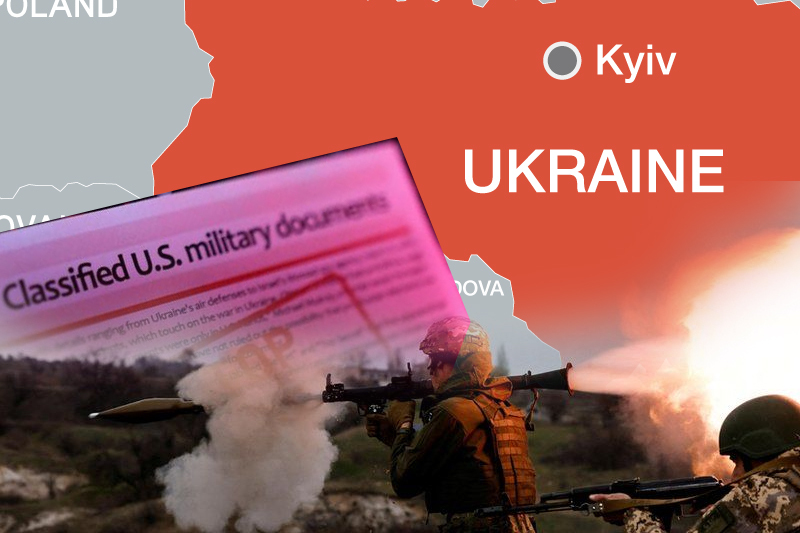
What did America uncover in war documents and relations with Europe?
Special forces from Europe are present in Ukraine. Nearly half of the tanks traveling to Kyiv are coming from Poland and Slovenia. Hungary may also be allowing weapons to fly through its airspace.
Just a few of the intriguing facts about Europe’s involvement in the conflict can be found in a 53-page report POLITICO reviewed that was obtained from a leak of unconfirmed U.S. military intelligence documents.
The disclosure has caused a tempest of mind-boggling revelations, forcing the United States to play catch-up with allies. The documents explain American concerns about Ukraine’s spring offensive, imply that it spied on South Korea, and present evidence that Egypt was plotting to support Russia’s futile war, according to intelligence.
However, most of Europe has been spared from these damaging revelations.
But that doesn’t mean that there isn’t information in the documents about Europe’s war effort. Insights into everything from a U.K.-dominated special forces group in Ukraine to how and when France and Spain are deploying a crucial missile system to the front lines are revealed in the leaked files. The documents also make claims that Russian mercenaries could obtain weapons from Turkey.
There have been hints that some of the leaked pages were altered, and POLITICO has not independently verified the documents. However, the United States has admitted the intelligence failure and detained a suspect late on Thursday.
Here are a few of POLITICO’s conclusions after carefully reading the document.
The European Union is present there.
According to the documents, a special forces group with a heavy European component is currently operating in Ukraine, at least as of March 23.
With 50 members of the special forces, the UK dominates the 97-person “US/NATO” contingent. 17 members of Latvia, 15 members of France, and one member of the Netherlands are also in the group. The team is completed of 14 Americans.
The details of the activities the forces are engaged in or where they are in Ukraine are not disclosed in the leaked information. The documents also reveal that roughly 100 Americans are working there in total.
Governments have, predictably, mostly kept quiet about the issue. The British have declined to comment, but the White House has acknowledged a “small U.S. military presence” at the U.S. embassy in Ukraine while emphasizing that the soldiers “are not fighting on the battlefield.” In the past, France has refuted claims that its troops are “engaged in operations in Ukraine.”
Requests for comment from the other nations went unanswered.
The majority of the tanks come from Europe.
Keep Reading
One area where Europe is outperforming America is in tanks.
One page of the document provides a summary of the 200 tanks that the United States’ allies have agreed to send to Ukraine, which is 53 fewer than what the document claims Ukraine will need for its spring offensive.
According to a report dated February 23, Poland and Slovenia appear to be the biggest donors, contributing nearly half of the total. With 14 tanks each, France and the U.K. are also significant contributors.
The Leopard 2 team is also contributing models of the contemporary German battle tanks that Ukraine spent months persuading allies it needed. Germany, Norway, Portugal, Spain, Greece, and Finland are included in that group.
The document claims Germany had only committed four Leopard 2s, the most expensive model, but Berlin claimed in late March to have given Ukraine 18 Leopards. Additionally, it shows Sweden promising to provide 10 tanks of an “unknown type,” possibly Leopards, according to media reports.
Separately, the United States has declared that it will send 31 of its cutting-edge tanks to Ukraine, though those aren’t anticipated to arrive until at least the fall.
Deliveries in Europe are also running late.
The rationale for Europe taking the lead in tank development included the ability to quickly transport battle-ready tanks to Ukraine, ideally in time for the spring offensive.
However, the document reveals that as of February 23, only 31% of the 200 pledged tanks had arrived on the front lines. However, it did mention that the transfer of the remaining 120 tanks was scheduled to happen.
Separately, according to another page that was leaked, France informed Italy on February 22 that a joint missile defense system for Ukraine wouldn’t be ready until June. The Italian defense ministry provided a timeline in February, stating that the anti-aircraft defense system would be delivered to Ukraine “in the spring of 2023.” That marks the very end of that timeline.
Hungary may be allowing allies to use its airspace despite viewing America as the enemy.
In the stack of creased pages, Hungary appears a few times, providing additional details about a nation that frequently confounds its allies.
In a “top secret” CIA update from March 2, it is revealed that Viktor Orbán, the prime minister of Hungary, named the United States as “one of his party’s top three adversaries” on February 22 during a political strategy session. This information is the most startling.
It states that Orbán’s comments represent “an escalation of the level of anti-American rhetoric”.
Orbán’s administration has steered its course throughout the conflict, supporting narratives that are friendly to Russia, essentially urging Ukraine to end the conflict, and caustically dismissing efforts by allies to isolate Russia’s economy.
Despite promises to prevent such transfers, the leaked U.S. documents also suggest Hungary, which has a small border with Ukraine, maybe secretly allow allies to use its airspace.
One of the documents that were leaked describes a scheme for Ukrainian pilots to transport helicopters that had been donated from Croatia to Ukraine “through Hungarian air space.” If accurate, the information would refute press reports that the helicopters would be transferred on the ground or via flights into Poland and would also show that Hungary is allowing arms to pass through its skies.
Officials from Croatia and Hungary did not respond to requests for comment.
Did the British play down the possibility of war with Russia?
The UK has maintained a consistent narrative in public: Over the Black Sea in September of last year, a Russian fighter jet “released” a missile “in the vicinity” of a British surveillance aircraft. Undoubtedly a close call, but not a serious incident.
However, the leaked American dossier raises concerns about a more serious matter. As a “near shoot-down” of the British aircraft, the incident is described. The language seems to go beyond what Ben Wallace, the defense secretary for the United Kingdom, told lawmakers in October. The Russian pilot had locked on the British aircraft before the missile misfired, according to a report this week in The New York Times.
The document also describes several other recent close calls between Russian fighter jets and American, British, and French surveillance aircraft; this topic made headlines last month when a Russian fighter jet collided with an American drone, sending it plunging into the Black Sea.
Wallace hasn’t responded to the description that was leaked, and a ministry spokesperson on Thursday cited a previous statement that claimed the disclosed dossier contained a “serious level of inaccuracy” and cited it as support.
Turkey- The middleman of war in Europe
Turkey has positioned itself as a mediator between Ukraine and Russia, aiding in the negotiation of an agreement to maintain the flow of grain shipments through the Black Sea, maintaining diplomatic ties with Russia, and supplying drones to Ukraine.
However, the cache of leaked covert U.S. intelligence reports reveals a darker side to Turkey’s role as a middleman that blatantly benefits Russia.
One page explains how Turkey assisted Belarus, a Russian ally, in evading severe Western sanctions, which worries U.S. officials have made public.
The document claims that “Turkish companies purchased sanctioned goods” for Belarus and “sold them in European markets.” It continues by saying that these businesses “resold goods from Europe to Russia.”
Another leaked document, which describes a February meeting between “Turkish contacts” and the Wagner Group, the private militia company fighting for the Kremlin, is even more concerning. Wagner, according to the report, wanted “to purchase weapons and equipment from Turkey” for the group’s “efforts in Mali and Ukraine.”
The information, which the document claims was gleaned from “signals intelligence”—a cover for digital surveillance—does not clarify whether the purchases have taken place.
An inquiry for comment was not immediately answered by the Turkish Foreign Ministry.




